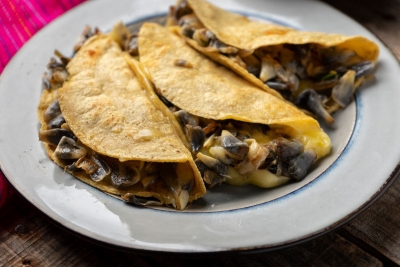Which experiments and innovations people did with pizza?

Mount Vesuvius and the first pizzeria
What does Mount Vesuvius have to do with pizzas, other than they're both from Italy? Up until the early 19th century, pizzas were sold by street vendors, baked on wood-fire ovens. And then opened Antica Pizzeria Port' Alba in 1830 considered to be the first pizzeria in the world. The pizzas were baked in ovens lined with lava rocks from Mount Vesuvius. What's hotter is the payment system back then, called pizza a otto, that allowed customers to pay up to eight days after enjoying a pizza. Three cheers to Port' Alba that exists to this day!
Pizza...served on pizz
Vinnie's Pizzeria is surely winr hearts with what they have on offer on their menu. Seriously, who wouldn't want to enjoy a slice of pizza topped with mini slices of pizza. But that's not the only thing they're famous for. They're famous for coming up with a delightful packing solution for pizzas. Why give pizzas in cardboard boxes that can't be gobbled up? The solution - a box made of pizza that you can eat after you finish the pizza inside!
Pizzas with a technological edge
Having trouble choosing one pizza from among a bunch of delicious ones? You're not alone! A Swedish company has decided to take up the matter to set things right. And thus comes about the "subconscious menu". The technology scans people's eye movements while they look at toppings, offering one from thousands of different combinations. Let's save time clicking or speaking and pray that this technology is whole-heartedly embraced by all pizzerias.
A $2000 extravaganza
The world is obsessed with super-expensive food items, and the pizza hasn't been spared the extravagant décor and the accompanying price tag. Industry Kitchen is a restaurant in New York's posh financial district. Rush and order this precious $2000 pizza if you like these toppings: truffle, French foie gras, English Stilton cheese, caviar, and 24-carat gold leaves! Enjoy a pizza that's worth about $50 a bite!
The humble origin of Pizza Margherita
Pizzeria di Pietro e Basta Cosi (the name is quite a mouthful) in Naples, Italy is credited with being the birthplace of modern pizza. Until that time, pizza was food for the poor, hurriedly assembled together from leftover ingredients on a piece of flatbread. For Queen Margherita who had travelled to Italy, a special pizza was put together using mozzarella, tomatoes and basil, representing the colors of the Italian flag. Apparently, that was the first time it was made with mozzarella and the first time it was enjoyed by a queen. That pizza was the lucky charm - today Pizza Margherita is popular just about everywhere.
Fresh robot pizza
Zume Pizza, founded in 2015, decided that they needed more than human hands shaping and topping the pizza. So, the company invested in robotic devices to lovingly squirt out tomato sauce, spread it with precision onto the pizza base, and place it in the hot ovens, For those among us who care about beauty and perfection in their slices, this seems to be the deal. For the rest of us, pizza is pizza!
Picture Credit : Google
